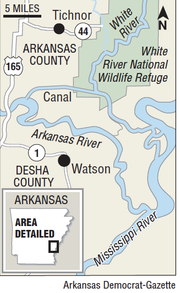A $3 million, three-year study aims to finally find a permanent fix to the threat of a potentially catastrophic breach of the McClellan-Kerr Arkansas River Navigation System.
For now, the U.S. Army Corps of Engineers has been making increasingly expensive temporary repairs to the Three Rivers area at the confluence of the Arkansas, White and Mississippi rivers in southeast Arkansas, said Gene Higginbotham, executive director of the Arkansas Waterways Commission.
"The Band-Aids keep getting bigger," he said.
A series of man-made structures protects the integrity of the navigation system at that point by keeping the White River separated from the lower Arkansas River. Flooding, however, periodically damages those structures.
A catastrophic breach could disrupt the flow of the rivers and halt barge traffic on the 455-mile navigation system that runs from Catoosa, Okla., to the Mississippi River for up to a year. Opened in 1969 at a cost of $1.4 billion -- representing at the time the Corps' most expensive project -- the system's 18 locks help keep the river in check for the barges that move more than 12 million tons of cargo worth nearly $4 billion annually. The navigation system also provides flood protection, hydropower, water supply and recreation benefits, according to the commission.
The focus of many of the repairs in the Three Rivers area is on the Melinda Structure, which is like a raised concrete road and acts as a levee separating the navigable portion of the White River from the unnavigable lower Arkansas. Barge traffic uses the White River to enter or exit the Mississippi. A canal 10 miles long in Arkansas County connects the White River with the navigable portion of the Arkansas.
The Melinda Structure was built in 1989 at a cost of $8.9 million. The latest project to repair the structure from damage suffered in flooding about three years ago cost $11 million. That damage occurred just after the Corps spent $9 million on repairs to it and other structures in the Three Rivers area. Another $15 million worth of work is scheduled in the area, Higginbotham said.
What typically happens is that water the Mississippi River can't handle backs up into the White as far as 10 miles, Higginbotham said. Such large amounts of water can overwhelm the man-made structures. The last event left the Melinda structure as if "a couple of F-16s bombed it," Higginbotham said.
The expensive repairs are necessary for the integrity of the navigation system, but the money takes away from ongoing maintenance of the system's 17 locks and dams. A permanent fix would free money from the Corps' maintenance and operations accounts to clear the backlog of work on the locks and dams, Higginbotham said.
The Corps is providing $1.5 million for its share of the study costs. The Arkansas Legislature appropriated $1.5 million to pay for the balance of the study, which will, among other things, investigate environmental and engineering challenges of a permanent fix and come up with an accurate cost, Higginbotham said.
The money came from Gov. Asa Hutchinson's portion of the General Improvement Fund, which totals $20 million.
"It's vitally important to protect our navigation system and river commerce, which has an enormous economic impact on Arkansas," Hutchinson said in a prepared statement. "By funding this study, we will better be able to investigate and prevent threats to navigation."
Metro on 04/20/2015

